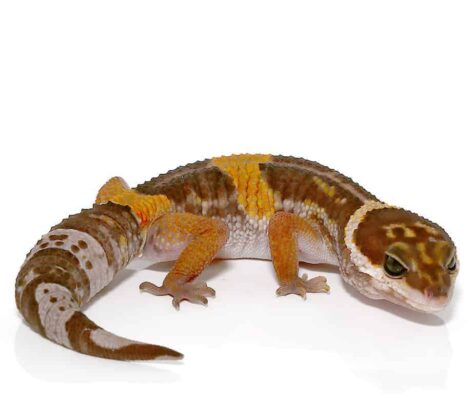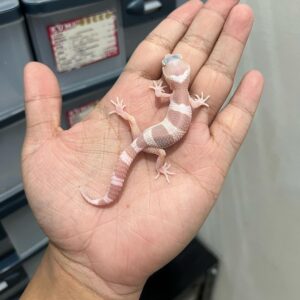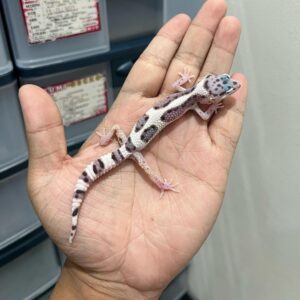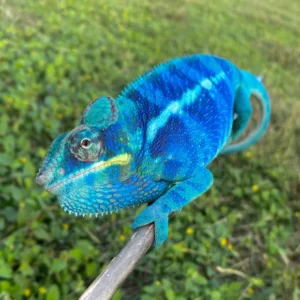East Indian Leopard Gecko For Sale
$399.99
WE HAVE AN EAST INDIAN LEOPARD GECKO FOR SALE. HERE ARE SOME HIGHLIGHTS:
- Eublepharis hardwickii
- Captive Bred
- Female
- Roughly 48 Grams In Weight
- Approximately 7 Inches In Length
- Adults Can Reach Up To 7 – 9 Inches In Length From Head To Tail
- Feeding On Calcium Dusted Crickets & Mealworms
Description
The East Indian Leopard Gecko, scientifically known as Eublepharis hardwickii, is a captivating reptile native to the eastern regions of India. Distinguished by its vibrant patterns and unique morphological features, this gecko species stands out among its peers. Unlike its more commonly known relatives, the East Indian Leopard Gecko exhibits distinct adaptations that make it particularly suited to its natural habitat.
Primarily found in the subtropical and tropical dry forests, scrublands, and rocky terrains of Indian states such as Odisha, West Bengal, and Andhra Pradesh, these geckos have evolved to thrive in relatively harsh environments. Their coloration, which ranges from yellow to brown with striking black spots, provides excellent camouflage against the sandy and rocky landscapes they inhabit. This natural adaptation not only aids in avoiding predators but also enhances their hunting efficiency.
The East Indian Leopard Gecko typically measures between 7 to 10 inches in length, including its tail. One of its most distinctive features is the presence of movable eyelids, a trait that is relatively rare among gecko species. This characteristic, combined with their nocturnal nature, equips them to be proficient nighttime hunters, preying on insects and small invertebrates. The gecko’s robust limbs and claws further facilitate their agile movement across rugged terrains.
Another notable aspect of the East Indian Leopard Gecko is its ability to store fat in its tail, which serves as an energy reserve during periods of food scarcity. This physiological adaptation is crucial for survival in environments where food sources can be unpredictable. Additionally, their skin, which can shed periodically, helps them maintain hygiene and remove parasites.
In the realm of herpetology, the East Indian Leopard Gecko is recognized for its unique ecological and biological traits, making it an intriguing subject of study. Its distinctiveness, both in appearance and behavior, underscores the rich biodiversity found in India’s eastern regions and highlights the importance of conserving these habitats to ensure the survival of such remarkable species.
Physical Characteristics and Appearance
The East Indian Leopard Gecko is a captivating reptile renowned for its distinctive physical traits. Typically, this species measures between 7 to 10 inches in length, with males generally being slightly larger than females. Their robust build is complemented by a broad head and well-developed limbs, which contribute to their agile movements.
One of the most striking features of the East Indian Leopard Gecko is its skin texture. The skin is covered with small, granular scales that provide a unique, slightly rough feel, which contrasts with the smoother skins of other gecko species. This texture not only enhances their grip on various surfaces but also plays a crucial role in their ability to blend into their natural habitat.
Coloration and patterns are where the East Indian Leopard Gecko truly stands out. Their bodies are adorned with a vibrant array of colors, typically ranging from yellow to brown, interspersed with dark spots or rosettes that resemble a leopard’s markings, hence their name. These patterns can vary significantly among individuals, making each gecko uniquely identifiable. Unlike the more uniform coloration seen in some other gecko species, the East Indian Leopard Gecko’s intricate patterns provide excellent camouflage in their native environments.
In comparison to other gecko species, such as the Crested Gecko or the Tokay Gecko, the East Indian Leopard Gecko’s markings are more reminiscent of wild felines, which is not just a visual delight but also an evolutionary advantage. Their tails, often thick and segmented, serve as fat storage reserves, a feature common to many geckos but particularly pronounced in this species due to their often arid habitats.
These distinctive physical characteristics not only make the East Indian Leopard Gecko a subject of interest for herpetologists but also a popular choice among reptile enthusiasts. Their unique appearance, coupled with their docile nature, makes them a fascinating species worthy of admiration and study.
Habitat and Natural Environment
The East Indian Leopard Gecko, scientifically known as Eublepharis macularius, thrives in a specific set of environmental conditions found predominantly in the semi-arid and arid regions of India. These geckos have adapted remarkably well to their natural habitat, which is characterized by a unique combination of temperature, humidity, and terrain.
Typically, the East Indian Leopard Gecko flourishes in areas where daytime temperatures can soar to between 30°C and 35°C (86°F to 95°F) while nighttime temperatures drop to a cooler range of 20°C to 25°C (68°F to 77°F). This fluctuation in temperature is crucial for their thermoregulation, allowing them to maintain their body temperature optimally. The geckos often seek refuge under rocks or in burrows during the hottest part of the day to avoid overheating, emerging only during the cooler hours to hunt and forage.
Humidity levels in their natural habitat are relatively low, typically ranging from 30% to 40%. This arid environment helps prevent skin infections and other health issues that could arise from excessive moisture. Leopard Geckos have developed a thick, waxy skin that aids in water retention, enabling them to survive in such dry conditions. Additionally, they are known to occasionally absorb moisture from the soil or dew, which helps to meet their hydration needs.
The terrain these geckos inhabit is often rugged and rocky, interspersed with sparse vegetation. This type of landscape provides both the shelter and hunting grounds necessary for their survival. The rocks and crevices offer protection from predators and extreme weather, while also serving as ideal locations to ambush prey. The sparse vegetation supports a variety of insects, which constitute the primary diet of the East Indian Leopard Gecko.
Understanding the habitat and natural environment of the East Indian Leopard Gecko is essential for conservation efforts and for anyone interested in keeping these fascinating reptiles as pets. By replicating these conditions, enthusiasts can ensure the health and well-being of their geckos, providing them with an environment that closely mirrors their natural surroundings.
Diet and Feeding Habits
The East Indian Leopard Gecko boasts a diverse and intriguing diet primarily composed of insects and small invertebrates. As a nocturnal predator, it exhibits remarkable hunting prowess during the night, skillfully capturing a range of prey that includes crickets, mealworms, and other small arthropods. These geckos rely heavily on their keen eyesight and swift reflexes to catch their prey, making them efficient hunters.
In their natural habitat, East Indian Leopard Geckos typically seek out environments rich in insect life. They are particularly fond of crickets, which provide a substantial portion of their nutritional needs. In addition to crickets, they consume a variety of other insects such as beetles, ants, and spiders, further showcasing their adaptability and opportunistic feeding habits.
The hunting technique of the East Indian Leopard Gecko is a fascinating spectacle. They employ a combination of stealth and agility, stalking their prey with minimal movement before striking with precision. Their sticky tongues aid in capturing and securing their meals, allowing for an efficient and effective feeding process. This predatory behavior is not only essential for their survival but also highlights their evolutionary adaptations.
Unique feeding behaviors have been observed in these geckos, including their ability to consume prey larger than their head size. This is achieved through their flexible jaw structure, which allows them to dislocate and engulf sizable prey items. Additionally, East Indian Leopard Geckos have been noted to exhibit food-storing behaviors, where they may hide excess food for later consumption, a trait that ensures they have a food supply during scarce periods.
Overall, the diet and feeding habits of the East Indian Leopard Gecko underline its adaptability and resourcefulness. These behaviors not only contribute to their survival in the wild but also provide valuable insights into their ecological role and the intricate dynamics of their natural environment.
Behavior and Temperament
The East Indian Leopard Gecko, known for its distinctive appearance and engaging behavior, presents a captivating subject for enthusiasts and researchers alike. This gecko species exhibits a range of behaviors that offer insight into its daily life and interactions within its habitat. Primarily nocturnal, the East Indian Leopard Gecko is most active during the twilight hours and night, when it emerges to hunt and explore. This nocturnal activity aligns with the gecko’s instinctual drive to avoid predators and extreme daytime temperatures in its natural environment.
In terms of social behavior, the East Indian Leopard Gecko is generally solitary by nature. While they can be housed together, caution is advised, particularly with males, who may display territorial aggression. Female geckos, on the other hand, tend to be more tolerant of each other’s presence, although individual temperaments can vary. This species communicates through a variety of vocalizations and body language, including tail waving and chirping, which help them establish dominance or signal distress.
When interacting with their environment, East Indian Leopard Geckos are known for their curious and exploratory nature. They frequently investigate their surroundings, making use of their keen sense of smell and sight. Their ability to climb and burrow allows them to navigate complex terrains, which is essential for their survival in the wild. Notably, these geckos exhibit a unique behavior known as tail autotomy, where they can detach their tail as a defense mechanism to escape predators. The tail will eventually regenerate, though it may not appear exactly the same as the original.
Overall, the East Indian Leopard Gecko’s behavior and temperament make it a fascinating species to observe. Its nocturnal habits, social dynamics, and environmental interactions provide a comprehensive understanding of its lifestyle, highlighting the importance of appropriate habitat conditions and social considerations for those interested in keeping these geckos as pets.
Reproduction and Lifespan
The reproductive cycle of the East Indian Leopard Gecko is an intriguing aspect of its biology. Mating behaviors typically commence during the early months of the year, coinciding with the warmer temperatures of spring and summer. Male geckos engage in a series of ritualistic displays to attract females, including tail waving and vocalizations. Upon successful mating, the female enters a gestation period that lasts approximately 20 to 30 days.
During this gestation period, the female’s abdomen gradually enlarges as the eggs develop. Once the eggs are ready to be laid, the female seeks out a secure and moist location to deposit them. Typically, a clutch consists of two eggs, and females may lay multiple clutches throughout the breeding season. The eggs are buried in substrate to ensure they remain at a stable temperature and humidity, which are crucial for successful incubation. The incubation period lasts around 45 to 60 days, depending on environmental conditions such as temperature and humidity.
Upon hatching, the juvenile geckos are independent and receive no parental care. Their survival hinges on their ability to forage for food and avoid predators. In the wild, the East Indian Leopard Gecko’s lifespan averages around 10 to 15 years. However, in captivity, where threats are minimized and conditions are controlled, they can live up to 20 years or more. Several factors influence their longevity, including diet, habitat quality, and overall health.
Proper care in captivity involves providing a diet rich in insects, maintaining optimal temperature and humidity levels, and ensuring a clean living environment. Regular veterinary check-ups can also play a pivotal role in identifying and addressing health issues early. Conversely, in the wild, their lifespan can be curtailed by predation, habitat destruction, and climate variations. Understanding these dynamics is essential for conservation efforts aimed at preserving this remarkable species.
Conservation Status and Threats
The East Indian Leopard Gecko, also known as Eublepharis hardwickii, has garnered significant attention due to its unique characteristics and growing popularity among reptile enthusiasts. However, its conservation status is of particular concern in recent times. The species is currently classified as “Near Threatened” on the IUCN Red List, signifying that it faces a risk of extinction in the near future if the factors contributing to its decline are not effectively managed.
One of the primary threats to the East Indian Leopard Gecko is habitat loss. Rapid urbanization and agricultural expansion have resulted in significant deforestation, leading to the destruction of the gecko’s natural habitats. Additionally, climate change poses a severe threat by altering the gecko’s habitat conditions, affecting its ability to find food and suitable shelter. The changing weather patterns and increasing temperatures can significantly impact the species’ reproductive success and overall survival.
Human activities also play a crucial role in the decline of this species. Illegal collection and trade of these geckos for the pet industry have escalated, further endangering their populations in the wild. Moreover, the use of pesticides and other chemicals in agriculture can contaminate the gecko’s habitat, posing health risks and reducing their prey availability.
To address these threats, various conservation efforts have been initiated. Protected areas have been established to conserve critical habitats and safeguard the East Indian Leopard Gecko from further habitat destruction. Conservation organizations are actively involved in monitoring populations and conducting research to understand the species’ ecology better. Additionally, efforts are being made to educate local communities and raise awareness about the importance of preserving this unique reptile.
Legislation is also in place to regulate the trade of East Indian Leopard Geckos. For instance, CITES (the Convention on International Trade in Endangered Species of Wild Fauna and Flora) has included the species in its appendices to control and monitor international trade. These combined efforts aim to ensure the long-term survival of the East Indian Leopard Gecko in the wild.
Caring for East Indian Leopard Geckos in Captivity
East Indian Leopard Geckos are fascinating reptiles that can thrive in captivity when provided with the appropriate care. Housing these geckos necessitates a secure and comfortable environment. A 20-gallon tank is typically sufficient for a single adult leopard gecko, although larger enclosures are recommended for multiple geckos. The tank should include a secure lid to prevent escapes, along with ample hiding spots created from rocks, logs, or commercially available hides. These hiding places are crucial for the geckos to feel safe and reduce stress.
Temperature regulation is vital for the well-being of East Indian Leopard Geckos. They thrive in a temperature gradient with the warm side of the enclosure maintained between 88-92°F (31-33°C) and the cool side between 75-80°F (24-27°C). Nighttime temperatures can safely drop to around 70°F (21°C). An under-tank heating pad or ceramic heat emitter can be used to maintain these temperatures. It is essential to use a thermostat to prevent overheating and ensure consistent temperature control.
Diet plays a significant role in the health of East Indian Leopard Geckos. Their diet in captivity should consist primarily of live insects such as crickets, mealworms, and dubia roaches. To ensure a balanced diet, these insects should be gut-loaded with nutritious foods before being offered to the geckos. Additionally, dusting the insects with a calcium and vitamin D3 supplement is necessary to prevent metabolic bone disease and other deficiencies.
Health care is another critical aspect of maintaining East Indian Leopard Geckos in captivity. Regular check-ups with a reptile veterinarian can help detect and address health issues early. It is also important to monitor the gecko for signs of illness, such as changes in appetite, weight loss, or abnormal feces. Maintaining proper hygiene by cleaning the enclosure regularly and providing fresh water will help prevent infections and promote overall health.
In conclusion, with proper housing, temperature regulation, diet, and health care, East Indian Leopard Geckos can lead a healthy and fulfilling life in captivity. By understanding and meeting their specific needs, owners can enjoy the company of these captivating reptiles for many years.







